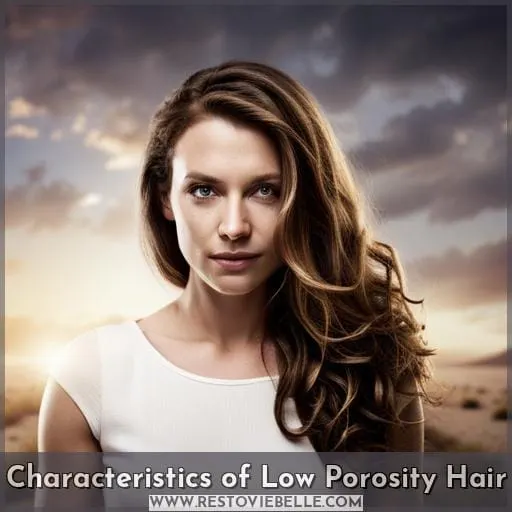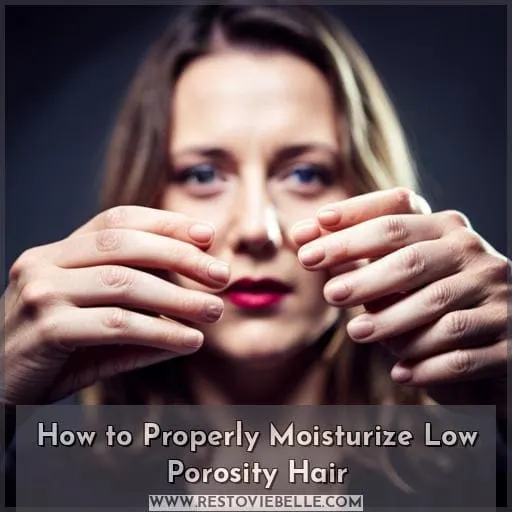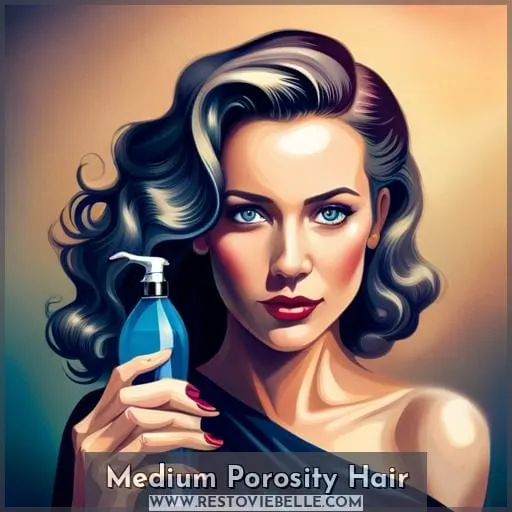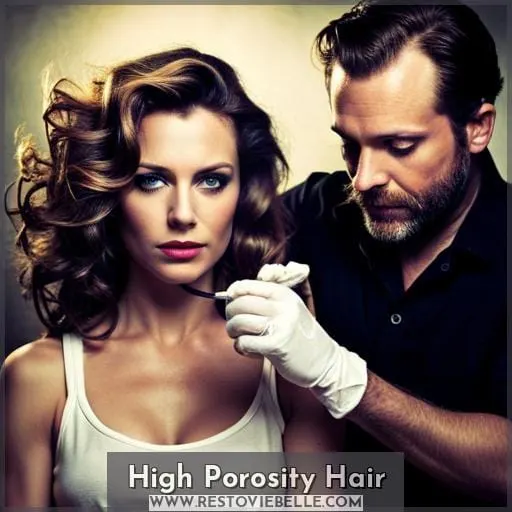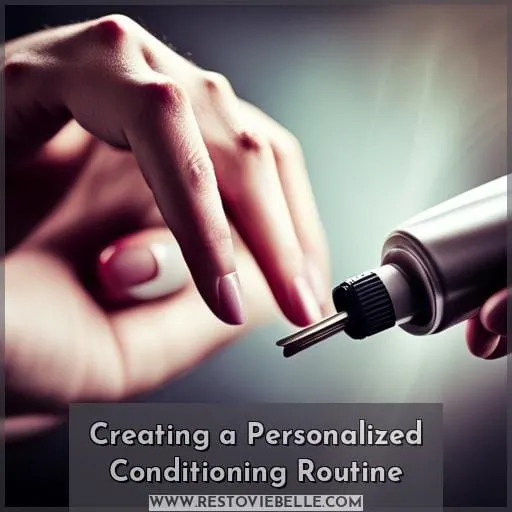This site is supported by our readers. We may earn a commission, at no cost to you, if you purchase through links.
 Discover the best conditioning routine for your low porosity hair.
Discover the best conditioning routine for your low porosity hair.
Are you unsure how often to condition? We’ve got you covered.
Low porosity hair can be challenging to moisturize due to its tightly closed cuticles. To keep your locks hydrated and healthy, aim for conditioning every 2-3 days or as needed based on your hair’s needs.
Don’t forget to protect it from heat styling and environmental factors like sun exposure.
Table Of Contents
- Key Takeaways
- What is Low Porosity Hair?
- Characteristics of Low Porosity Hair
- How to Determine if You Have Low Porosity Hair
- How Often Should You Wash Low Porosity Hair?
- How to Properly Moisturize Low Porosity Hair
- Tips for Managing Low Porosity Hair
- Medium Porosity Hair
- High Porosity Hair
- Common Mistakes to Avoid With Low Porosity Hair
- Creating a Personalized Conditioning Routine
- Frequently Asked Questions (FAQs)
- Can low porosity hair benefit from using a leave-in conditioner?
- Are there any specific ingredients to avoid when conditioning low porosity hair?
- Is it recommended to use heat tools on low porosity hair?
- Can low porosity hair benefit from using protein-based hair products?
- How often should deep conditioning treatments be done for low porosity hair?
- Conclusion
Key Takeaways
- Conditioning low porosity hair should be done regularly to maintain moisture.
- Deep conditioning once a week is recommended for optimal results.
- Diluting conditioner can help with absorption and prevent buildup.
- Pre-pooing your hair before conditioning can aid in the moisturization process.
What is Low Porosity Hair?
Low porosity hair refers to hair that has tightly aligned cuticles, creating a barrier for moisture to enter.
This type of hair is water-resistant and can be more challenging to absorb water and moisture, including hair products.
You may notice that products tend to sit on top of your low porosity hair instead of penetrating the strands.
Additionally, you might experience buildup more often and your hair may feel weighed down or take longer to get fully wet in the shower.
To determine if you have low porosity hair, try conducting a simple test by placing a strand of clean dry hair in a glass of water – if it floats or takes an extended period before sinking then it’s likely that you have low porosityhair.
Characteristics of Low Porosity Hair
Low porosity hair has several distinct characteristics that can impact how often you should condition it.
First, this type of hair has difficulty absorbing moisture, which means it may require a different approach to conditioning.
Additionally, low porosity hair is prone to buildup and product residue due to its water-resistant nature.
Lastly, low porosity hair tends to have a slower drying time compared to other types of hair.
Understanding these characteristics will help guide your conditioning routine for optimal results with low porosity hair.
Difficulty Absorbing Moisture
If you have low porosity hair, you may struggle with the difficulty of absorbing moisture.
To combat this issue, try using:
- Water-based products
- Lightweight leave-in conditioners
Apply these products to damp hair for better absorption.
Consider pre-poo treatments and steam your hair to open up the cuticles.
Avoid heavy oils, butters, and protein products that can weigh down your low porosity hair.
Buildup and Product Residue
To address the issue of buildup and product residue in low porosity hair, it’s important to understand how these characteristics can affect your hair care routine.
To avoid buildup, use water-based products and lightweight leave-in conditioners.
Apply products to damp hair and consider using a hair mask for deep conditioning.
Avoid heavy oils that can contribute to buildup on low porosity hair.
Slow Drying Time
When dealing with low porosity hair, you may notice that your hair takes longer than usual to air dry. This is due to the tight cuticle layer of low porosity hair, which makes it more difficult for water to penetrate and evaporate.
- Use heat: Using a diffuser or hooded dryer on low heat can help accelerate the drying process.
- Avoid excessive manipulation: Constantly touching and moving your wet hair can prolong drying time.
- Blot excess moisture: Gently blotting your hair with a microfiber towel or t-shirt can remove excess water without causing frizz.
- Opt for lightweight products: Choosing lighter leave-in conditioners and styling products will prevent weighing down the strands and allow them to dry faster.
- Try air-drying techniques: Experimenting with different methods like plopping or twist-outs can help distribute airflow evenly throughout your damp locks.
By following these tips, you’ll be able to minimize slow drying times while maintaining healthy, well-hydrated low porosity hair.
How to Determine if You Have Low Porosity Hair
To determine if you have low porosity hair, assess the moisture absorption and drying time of your hair.
- Your hair feels dry and lacks moisture even after applying products.
- Your hair takes a long time to absorb water when wetting it in the shower.
- It’s slow to dry once washed or styled.
Low porosity hair tends to be tightly coiled with fine strands, making it prone to breakage. This type of hair can also look oily due to product buildup that sits on top of the cuticles instead of penetrating them.
Additionally, low porosity hair may feel hard to style and dense because it struggles with absorbing moisture effectively.
How Often Should You Wash Low Porosity Hair?
Now that you know how to determine if you have low porosity hair, let’s talk about how often you should wash it. Washing your hair plays a crucial role in maintaining its health and managing buildup.
- Wash once a week: Aim to wash your low porosity hair once a week to prevent product buildup and maintain moisture balance.
- Use water-based products: Opt for lightweight, water-based products that can easily penetrate the tightly closed cuticles of your low porosity strands.
- Apply products to damp hair: Before applying any styling or conditioning products, make sure your hair is damp but not soaking wet. This will help the product absorb better into the strands.
Lastly steam treatments like hot oil treatments or steaming sessions at home also work wonders by helping open up those stubbornly sealed cuticles allowing more moisture absorption.
How to Properly Moisturize Low Porosity Hair
To properly moisturize low porosity hair, there are several techniques you can try.
- Regular deep conditioning is essential to provide your hair with the moisture it needs.
- Diluting your conditioner with water can help it penetrate the cuticles more easily.
- Using hot oils as a pre-poo treatment before shampooing can also help moisturize and nourish your low porosity hair.
Regular Deep Conditioning
Make regular deep conditioning a priority for properly moisturizing your low porosity hair.
Deep condition once a week using the best deep conditioners for low porosity hair, leaving it on for 15-30 minutes or overnight.
Diluting Conditioner
When conditioning low porosity hair, it’s important to dilute the conditioner with water. This helps ensure proper moisturization by allowing the product to penetrate the hair more effectively.
Find a frequency that works best for your hair type and needs.
Using Hot Oils
To properly moisturize low porosity hair, start by using hot oils.
- Apply the oil to damp hair, focusing on the ends.
- Leave it in for 30 minutes to an hour before rinsing out.
Use lightweight oils like argan or jojoba for best results.
Hot oils help penetrate the cuticles and provide deep hydration, improving moisture retention and preventing dryness and breakage.
However, be cautious not to use too much heat as it can damage your hair strands if used excessively or at high temperatures.
Pre-Pooing Your Hair
To properly moisturize low porosity hair, enhance your routine by incorporating a pre-poo treatment.
Pre-pooing provides numerous benefits, such as:
- Increasing moisture absorption
- Reducing product buildup
To pre-poo, apply oils or conditioners to damp hair before washing.
Repeat weekly for best results.
Tips for Managing Low Porosity Hair
To effectively manage your low porosity hair, try incorporating these tips into your routine:
-
Use water-based products:
Since low porosity hair has difficulty absorbing moisture, it’s important to use lightweight products that won’t weigh down your hair. Look for formulas that are water-based and free from heavy oils.
-
Avoid heavy oils:
Heavy oils can easily build up on low porosity hair and make it feel greasy or weighed down. Opt for lighter alternatives like argan oil or jojoba oil if you need extra hydration.
-
Use a leave-in conditioner:
Applying a leave-in conditioner to damp hair can help lock in moisture throughout the day without weighing down your strands. Look for a leave-in conditioner specifically designed for low porosity hair to ensure maximum effectiveness.
Medium Porosity Hair
For those with medium porosity hair, a balanced approach to conditioning is key.
Medium porosity hair has the ability to absorb and retain moisture more easily than low porosity hair, but it still requires regular conditioning to maintain its health and hydration.
Aiming for moderate dry conditioning sessions using light oils can help keep your medium porosity hair nourished without overwhelming it with too much product or weighing it down.
Moderate Dry Conditioning
For medium porosity hair, a moderate dry conditioning routine is essential to maintain moisture levels and promote healthy hair.
Avoid heavy butters and protein treatments, as they can weigh down your strands.
Instead, opt for lightweight oils that will nourish your hair without causing buildup.
To effectively condition your medium porosity locks, apply the conditioner to damp hair after washing with warm water. This method allows for better absorption of the product and leaves your strands hydrated and manageable.
Using Light Oils
If you have medium porosity hair, you can enhance your conditioning routine by incorporating light oils.
Light oils are a great alternative to heavy oils because they won’t weigh down your hair or cause buildup.
When using light oils, it’s important not to overdo it – a little goes a long way.
As for frequency, applying oil once or twice a week should be sufficient for medium porosity hair.
The best oils for low porosity hair include argan oil, jojoba oil, and grapeseed oil.
To apply the oil effectively, warm it up between your palms and then distribute evenly through damp or dry strands from mid-lengths to ends.
High Porosity Hair
When it comes to high porosity hair, using oily conditioners can help seal in moisture and prevent further damage.
Deep conditioning treatments should be emphasized to provide intense hydration and repair damaged cuticles.
Additionally, considering protein treatments can help strengthen the hair shaft and reduce breakage for high porosity hair types.
Using Oily Conditioners
You should use oily conditioners sparingly to avoid weighing down your high porosity hair.
Oily conditioners for low porosity hair can be heavy and contribute to buildup.
Instead, opt for lighter conditioners that won’t leave residue or make your hair feel greasy.
Use them in moderation and focus on proper moisture balance.
- Use oily conditioners in moderation
- Avoid heavy buildup
- Opt for lighter conditioners instead
- Maintain a proper moisture balance
Emphasizing Deep Conditioning
To properly care for high porosity hair, it’s important to emphasize deep conditioning in order to restore and maintain moisture levels.
Deep conditioning should be done once a week using the best deep conditioner for low porosity hair.
This will help nourish and hydrate your strands, preventing dryness and damage.
Consider Protein Treatments
When managing high porosity hair, consider incorporating protein treatments into your routine.
Protein treatments help strengthen and repair the damaged cuticles of high porosity hair.
However, be cautious not to overload with protein as it can lead to stiffness and brittleness.
Combine protein treatments with regular deep conditioning for optimal results.
Common Mistakes to Avoid With Low Porosity Hair
Now that you understand the characteristics of low porosity hair and how to properly moisturize it, let’s talk about some common mistakes to avoid.
Taking care of low porosity hair requires a delicate balance, so it’s important to be mindful of certain practices.
- Using heavy oils or butters: These can quickly accumulate on your hair, leading to buildup and weighing down your locks.
- Applying too much product: Overloading your hair with thick creams or excessive amounts of product will only create more buildup and make your strands feel dry.
- Not washing your hair enough: While low porosity hair doesn’t require frequent washing like other types, neglecting regular cleansing can cause your tresses to feel weighed down and dry.
- Avoiding protein products: Protein is essential for maintaining healthy strands. Limiting its use in products may result in stiffness and brittleness.
To keep optimal health for low porosity hair:
- Limit heat styling as much as possible.
By avoiding these common pitfalls, you’ll be able to maintain healthy-looking locks without sacrificing moisture retention or overall manageability.
Creating a Personalized Conditioning Routine
Figure out the best conditioning routine that works for your low porosity hair by experimenting with different products and techniques.
When it comes to deep conditioning, it’s recommended to do this once a week or every other wash day. Deep conditioning helps penetrate the hair shaft and provide much-needed moisture for low porosity hair.
Additionally, using a leave-in conditioner can help keep your hair hydrated throughout the week.
When applying products, make sure your hair is damp to allow better absorption.
As for what products to use, opt for water-based formulas and lightweight conditioners that won’t weigh down your strands or cause buildup.
To avoid buildup altogether, be mindful of not overusing heavy oils or cream-based products on your low porosity hair.
Frequently Asked Questions (FAQs)
Can low porosity hair benefit from using a leave-in conditioner?
Using a leave-in conditioner can benefit low porosity hair by:
- Providing lightweight moisture.
- Helping to penetrate the hair shaft.
- Aiding in hydrating your hair without causing buildup or weighing it down.
Are there any specific ingredients to avoid when conditioning low porosity hair?
When conditioning low porosity hair, it’s important to avoid:
- Heavy oils
- Thick cream-based products
These products can cause buildup.
Instead, opt for:
- Lightweight, water-based products
These products will penetrate the hair shaft and help absorb moisture better.
Is it recommended to use heat tools on low porosity hair?
Using heat tools on low porosity hair isn’t recommended.
The high heat can further damage the cuticle layer, making it even more difficult for moisture to penetrate the hair shaft.
It’s best to limit your use of heat tools and focus on gentle styling techniques instead.
Can low porosity hair benefit from using protein-based hair products?
Protein-based hair products can be beneficial for low porosity hair, as they help strengthen and nourish the hair shaft. However, it’s important to use them in moderation to avoid stiffness and brittleness.
How often should deep conditioning treatments be done for low porosity hair?
For low porosity hair, deep conditioning treatments should be done once every 1-2 weeks.
This helps to moisturize and nourish the hair, allowing it to better absorb and retain moisture.
Conclusion
To keep your low porosity hair moisturized and healthy, it’s important to condition regularly.
Aim to condition every 2-3 days or as needed based on your hair’s needs.
Low porosity hair can be challenging to moisturize due to its tightly closed cuticles, but by incorporating regular deep conditioning treatments, diluting conditioner, using hot oils, and pre-pooing your hair, you can maintain a proper moisture balance.
Don’t forget to protect your hair from heat styling and environmental factors, and consider a personalized conditioning routine to meet your specific needs.

